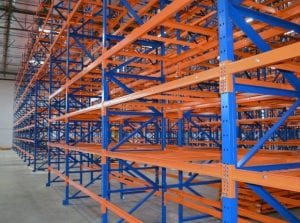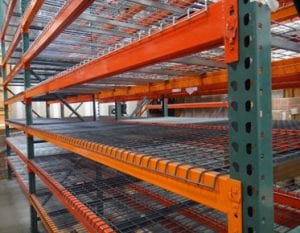Most anytime a company builds a new warehouse or expands their existing one, pallet racking is needed. The customer then has two mainstream options to consider…roll-formed pallet racking or structural steel. Is one style better than the other? Is the more expensive one worth the premium?
While there are varying degrees of opinions on both styles, the better questions to ask relates to what is being stored, the conditions surrounding your rack area and your expected growth. Both styles are widely used, can be extremely effective, and when applied correctly, are a wise investment. The big question to answer is which is BEST for your specific application. Let’s look at the fundamental differences of both styles of rack.
Structural Steel Racking
- Formed from hot-rolled steel channel welded together

- Beams and posts are bolted together
- Beam capacities range between 3,200 lbs. to greater than 12,000 lbs.
- Designed to withstand harsh conditions like freezer and outdoor applications
- Designed to better withstand high traffic and forklift impacts
- Requires less maintenance and lasts longer
- Common structural rack configurations include: selective, drive-In, push back and pallet flow
Based on this long list of features, structural steel rack is strong and sturdy and built to last in the harshest of conditions. All this strength does come at a premium however. Being that structural steel is heavier the cost per pound is greater than roll-formed racking. Additionally, delivery freight to the job site is usually more due to its increased weight and installation of structural racking is costlier as bolting the beams and uprights together is generally a slower process.
Roll-Formed Racking
- Formed from cold-rolled, lighter gauge sheet steel formed into a U or C- shape

- More versatile as it can be formed into various shapes to meet engineered systems like catwalks and pick modules
- Boltless beam pin connections for ease of installation
- More easily adjusted or reconfigured after initial installation
- Beam capacities range from 2,500 lbs. to as much as 9,000 lbs.
- Ideal for most warehouse storage applications
- More susceptible to forklift impact damage and typically costlier to replace or repair
- Common roll-formed steel configurations include: selective, push back, carton flow and pallet flow systems, rack-supported mezzanines and pick modules
New manufacturing processes and techniques continue to make roll-formed pallet racking more flexible and cost effective. The overarching consideration is the warehouse environment where the rack system will be installed. In a system where the products are lighter and there is minimal forklift interaction, roll-formed rack can be a solid, less costly option to consider. For freezer, cooler and high throughput applications, structural is generally preferred.
Find and Install Proper Racking
Work with an experienced material handling provider with engineering capabilities. They can help you determine which type of rack system is best suited for your specific throughput, application and ROI goals as well as offer customized consulting and design solutions.





Leave a Reply
You must be logged in to post a comment.